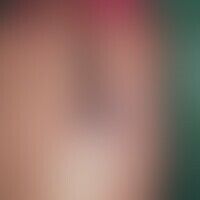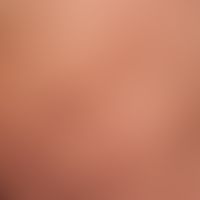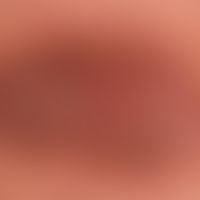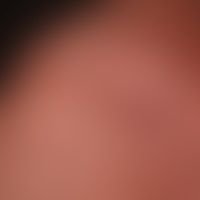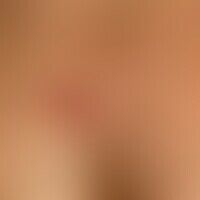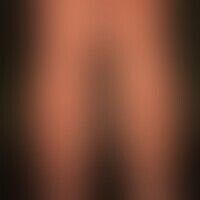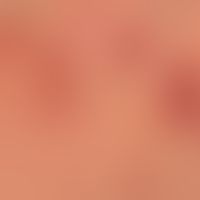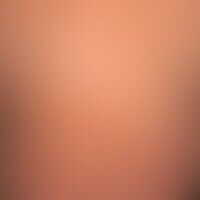Image diagnoses for "Nodule (<1cm)"
258 results with 980 images
Results forNodule (<1cm)

Keratoakanthoma classic type D23.L
Keratoakanthoma, classic type. short term, within 6-8 weeks grown, approx. 2.5 cm diameter, hard, reddish, centrally dented, strongly keratinized lump. no symptoms.

Angiosarcoma of the head and face skin C44.-
Angiosarcoma of the head and facial skin: the 69-year-old patient noticed this rapidly growing and recurrently bleeding 3x5 cm large, little symptomatic node around the capillitium for 6 months. After incomplete preliminary surgery within a few weeks formation of the present recurrent node. The inconspicuous erythema around the node is noticeable. After the micrographically controlled surgery, the tumor was only free of tumor after an approximately 10 x 10 cm large excision.

Keloid (overview) L91.0
Keloid. chronically stationary clinical picture. multiple, linear, skin-coloured smooth plaques that appear in the area of a tattoo and follow the given pattern.

Squamous cell carcinoma of the skin C44.-
Squamous cell carcinoma of the skin: hyperkeratotic, sharply defined red nodule which is painful under lateral pressure; histological: highly differentiated, spinocellular carcinoma

Bowenoids papulose A63.0
Bowenoid papulosis. 3 x 3 cm area with a verrucous, skin-coloured, central whitish keratotic-derbal nodule localised in SSL perianal at 12 and 1 o'clock. Multiple skin-coloured tumours in the perianal circumference. Two lenticular, dark brown, flat raised plaques, each 0.6 cm in size, with a smooth surface, appear on the left perineum. On the right labia majora there is a brownish-red, slightly infiltrated plaque with a smooth surface. The finding occurred in a 41-year-old woman who had been infected with HIV for 20 years (AIDS full picture stage C3).
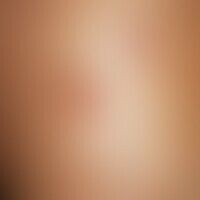
Prurigo simplex subacuta L28.2
Prurigo simplex subacuta:0.3-0.4 cm large, red, centrally eroded or ulcerated, moderately sharply defined, interval-like, violently itching papules, which are shown in the present image detail in different stages of development.
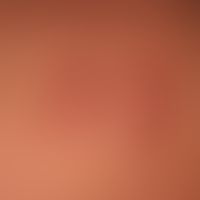
Keloid (overview) L91.0
Keloids: Flat, smooth-surfaced, firm, red nodules, increased vascular drawing. In this clinical picture a dermatofibrosarcoma protuberans can be excluded by differential diagnosis.

Acne keloidalis nuchae L73.0
Acne keloidalis nuchaeDetail magnification: Multiple, solitary or confluent, bright red papules, pustules and nodules, some of which are pierced by terminal hairs.

Neurofibromatosis (overview) Q85.0
type I neurofibromatosis, peripheral type or classic cutaneous form. numerous smaller and larger soft papules and nodules. several so-called café-au-lait spots.
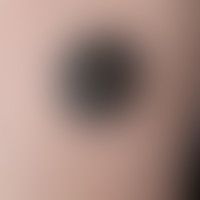
Melanoma nodular C43.L
Melanoma, malignant, nodular, " always present", solitary, asymptomatic, growing for more than a year, coarse, largely symmetrical node with atropically shiny surface,
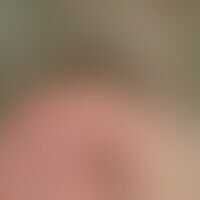
Keratosis seborrhoeic (overview) L82
Verruca seborrhoica. chronically stationary, solitary, brown to brown-black, exophytic node with wart-like surface, which has not been growing for years. in places a brown horn material can be easily detached from the surface.

Squamous cell carcinoma of the skin C44.-
Squamous cell carcinoma of the skin: large, fast-growing, painless, flat ulcerated lump, not displaceable over the base.
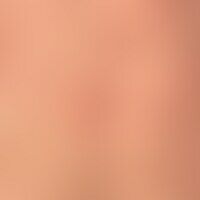
Acne (overview) L70.-

Lymphomatoids papulose C86.6
Lymphomatoid papulosis. 64-year-old patient with a history of 15 years. recurrent, intermittent course with formation of 4-10 painless nodules, which grow to the size shown here within a few days. rapid central ulceration. healing within 8-10 weeks leaving a sunken scar. recurrent secondary infections of the ulcerated nodules. previously known non-Hodgkin lymphoma in full remission.
